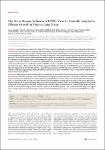The Novel Human Influenza A(H7N9) Virus Is Naturally Adapted to Efficient Growth in Human Lung Tissue
Knepper, Jessica
Schierhorn, Kristina L.
Becher, Anne
Budt, Matthias
Tönnies, Mario
Bauer, Torsten T.
Schneider, Paul
Neudecker, Jens
Rückert, Jens C.
Gruber, Achim D.
Suttorp, Norbert
Schweiger, Brunhilde
Hippenstiel, Stefan
Hocke, Andreas C.
Wolff, Thorsten
A novel influenza A virus (IAV) of the H7N9 subtype has been isolated from severely diseased patients with pneumonia and acute respiratory distress syndrome and, apparently, from healthy poultry in March 2013 in Eastern China. We evaluated replication, tropism, and cytokine induction of the A/Anhui/1/2013 (H7N9) virus isolated from a fatal human infection and two low-pathogenic avian H7 subtype viruses in a human lung organ culture system mimicking infection of the lower respiratory tract. The A(H7N9) patient isolate replicated similarly well as a seasonal IAV in explanted human lung tissue, whereas avian H7 subtype viruses propagated poorly. Interestingly, the avian H7 strains provoked a strong antiviral type I interferon (IFN-I) response, whereas the A(H7N9) virus induced only low IFN levels. Nevertheless, all viruses analyzed were detected predominantly in type II pneumocytes, indicating that the A(H7N9) virus does not differ in its cellular tropism from other avian or human influenza viruses. Tissue culture-based studies suggested that the low induction of the IFN-β promoter correlated with an efficient suppression by the viral NS1 protein. These findings demonstrate that the zoonotic A(H7N9) virus is unusually well adapted to efficient propagation in human alveolar tissue, which most likely contributes to the severity of lower respiratory tract disease seen in many patients.
Dateien zu dieser Publikation
Keine Lizenzangabe
Verwandte Publikationen
Anzeige der Publikationen mit ähnlichem Titel, Autor, Urheber und Thema.
-
2016-02-18ZeitschriftenartikelVaccine effectiveness in preventing laboratory-confirmed influenza in primary care patients in a season of co-circulation of influenza A(H1N1)pdm09, B and drifted A(H3N2), I-MOVE Multicentre Case–Control Study, Europe 2014/15 Valenciano, Marta; Kissling, Esther; Reuss, Annicka; Rizzo, C.; Gherasim, A.; Horváth, Judit K.; Domegan, L.; Pitigoi, Daniela; Machado, Ausenda; Bella, A.; Paradowska-Stankiewicz, I.; Larrauri, A.; Ferenczi, A.; O´Donell, Joan; Lazar, M.; Pechirra, P.; Korczyńska, M. R.; Pozo, Francisco; Moren, A.Influenza A(H3N2), A(H1N1)pdm09 and B viruses co-circulated in Europe in 2014/15. We undertook a multicentre case–control study in eight European countries to measure 2014/15 influenza vaccine effectiveness (VE) against ...
-
2016-10-13ZeitschriftenartikelImproving influenza virological surveillance in Europe: strain-based reporting of antigenic and genetic characterisation data, 11 European countries, influenza season 2013/14 Broberg, E.; Hungnes, Olav; Schweiger, Brunhilde; Prosenc, Katarina; Daniels, R.; Guiomar, R.; Ikonen, N.; Kossyvakis, A.; Pozo, Francisco; Puzelli, S.; Thomas, I.; Waters, A.; Wiman, Å.; Meijer, AdamInfluenza antigenic and genetic characterisation data are crucial for influenza vaccine composition decision making. Previously, aggregate data were reported to the European Centre for Disease Prevention and Control by ...
-
2013-02-14ZeitschriftenartikelEarly estimates of seasonal influenza vaccine effectiveness in Europe: results from the i-move multicentre case–control study, 2012/13 Valenciano, M.; Kissling, E.We conducted a test-negative case–control study based in five European sentinel surveillance networks. The early 2012/13 adjusted influenza vaccine effectiveness was 78.2% (95% CI: 18.0 to 94.2) against influenza B, 62.1% ...

